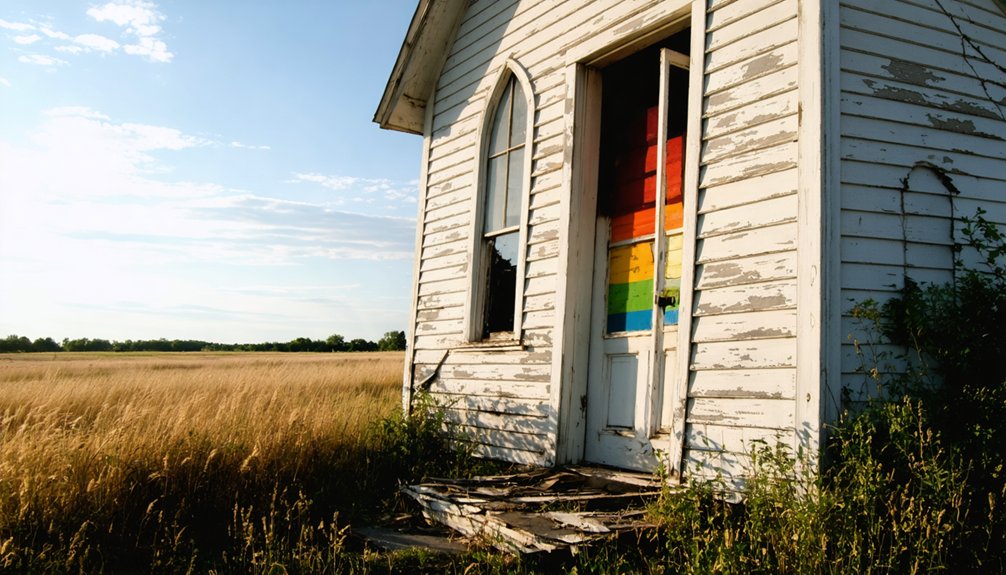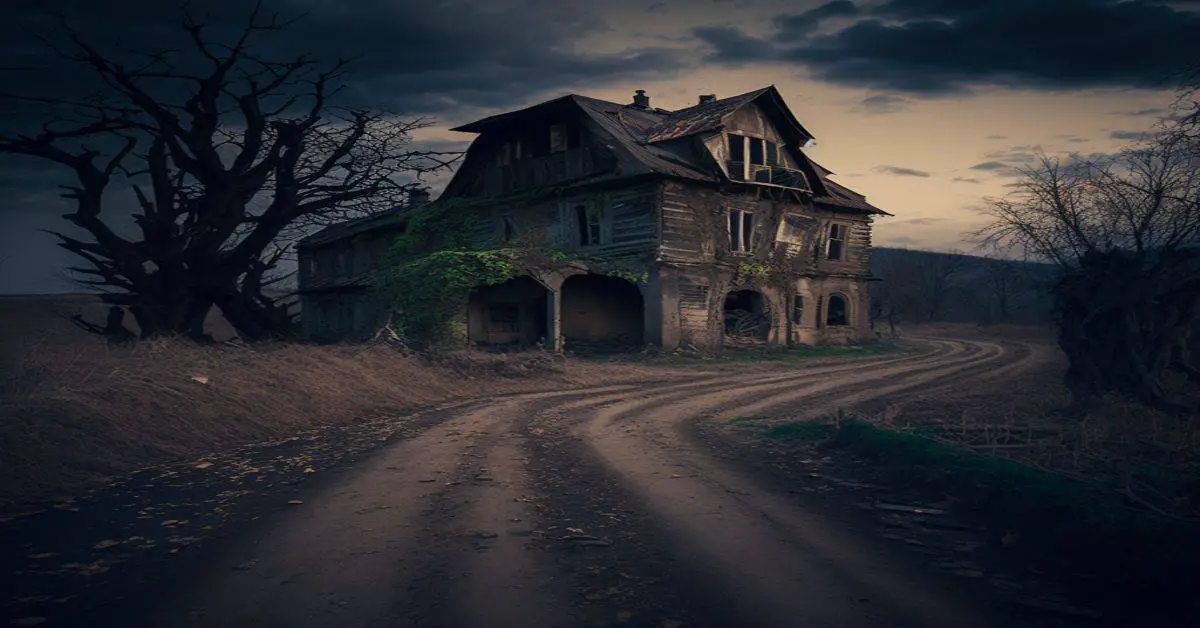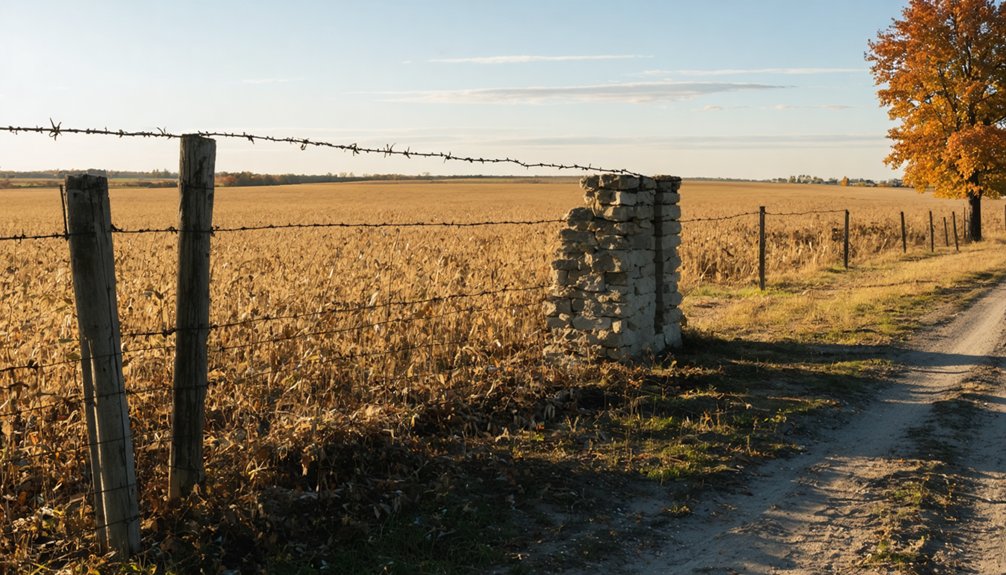You’ll find Millville’s haunting remains within Apple River Canyon State Park, where this once-bustling stagecoach stop thrived from 1835 to 1892. The town served travelers along the Chicago-Galena route, offering rest stops, provisions, and essential services. A catastrophic flood in June 1892 destroyed the settlement completely, forcing residents to abandon their homes. Today, archaeological findings and preserved ruins tell the story of this frontier community’s rise and dramatic end.
Key Takeaways
- Millville was established in 1835 as a stagecoach stop between Chicago and Galena before becoming a ghost town.
- The town served as a bustling service hub with sawmills, farms, and provisions for travelers until its destruction.
- A catastrophic flood in June 1892 destroyed all structures in Millville, forcing residents to permanently abandon the settlement.
- The ghost town’s remains are now preserved within Apple River Canyon State Park and listed on National Register of Historic Places.
- Archaeological excavations in 2001 uncovered artifacts and structural remains that reveal details about life in historical Millville.
The Birth of a Frontier Settlement (1835-1846)
While frontier settlements dotted the Illinois landscape in the 1830s, Millville emerged as a strategic service stop along the northern Chicago-Galena stagecoach route in 1835.
You’ll find the roots of this pioneer settlement in the efforts of John R. Smith and the Burbridge family, who built the town’s first structures, including a crucial sawmill between 1835 and 1836.
The location wasn’t chosen by chance – Millville’s position near Clear Creek and the South Fork Apple River provided essential resources for the growing community.
The fertile black soil attracted farmers, while the rural infrastructure began taking shape with the addition of homes and basic services. Early settlers relied heavily on accurate place name disambiguation to distinguish their town from other Millvilles across America.
Life Along the Stagecoach Trail
As stagecoaches rumbled through Millville between 1838 and 1853, the town flourished as an essential service hub at the intersection of the Chicago-Galena and Peoria-Galena routes.
You’d find weary travelers stopping to rest, change horses, and stock up on provisions while experiencing the harsh realities of frontier travel – bumpy roads, unpredictable weather, and long days of slow progress.
The town’s rural commerce revolved around meeting travelers’ needs. You could visit the blacksmith, find lodging for the night, or purchase supplies from local merchants.
The sawmill by the Apple River kept construction materials flowing, while news and mail from Chicago, Galena, and Peoria passed through regularly. Much like at Dixon’s crossing point, where hundreds of teams would gather to make their way across the Rock River, Millville saw its share of traffic congestion during peak travel seasons.
For a brief but significant period, these stagecoach experiences shaped Millville’s identity as a crucial link in northern Illinois’ transportation network.
Prosperity in the Apple River Valley
During the mid-1800s, the Apple River Valley emerged as a thriving economic hub built on lead mining, timber production, and fertile agricultural land. The discovery of lead near Galena in the 1820s sparked rapid development in the region.
You’d find economic diversification at every turn, from bustling sawmills in Millville to productive orchards yielding thousands of bushels of apples and peaches. The region’s wealth grew through agricultural innovation as settlers converted dense timberland into profitable farms. European immigrants provided essential labor for the growing industries.
You could witness the prosperity in the expanding transportation networks, including stagecoach routes and later railroads, that connected the valley to major markets.
Lead miners flocked to rich deposits near Galena, while farmers capitalized on the fertile Illinois Valley soil to grow maize and sorghum. The establishment of the Illinois & Michigan Canal further boosted trade, cementing the region’s economic success.
The Great Flood of 1892
The prosperity of the Apple River Valley came to an abrupt end in June 1892 when catastrophic flooding swept through Millville. Heavy rains overwhelmed the Cox Mill pond, leading to a devastating dam failure that released a torrent of water into Clear Creek and the South Fork Apple River.
You would’ve witnessed complete flood devastation as violent waters surged through the town’s heart, destroying every remaining structure in their path. The grist mill, blacksmith shop, and all other buildings were swept away, leaving nothing standing. The area had once been home to flourishing commerce thanks to the Illinois Central Railroad that transported livestock between Iowa and Chicago. The town had been a thriving community since its founding in 1835.
The disaster marked Millville’s final chapter, forcing residents to abandon their homes permanently. While the town’s physical presence vanished that day, its legacy lives on through its listing as a historic site and its incorporation into Apple River Canyon State Park.
Legacy and Preservation at Apple River Canyon
While Millville’s physical structures succumbed to the devastating flood of 1892, its historical significance lives on through preservation efforts at Apple River Canyon State Park.
You’ll find the ghost town’s heritage preservation showcased through its 2003 listing on the National Register of Historic Places. Archaeological findings from 2001 excavations have revealed essential insights into the town’s layout and daily life at this once-bustling stagecoach stop.
Today, you can explore the park’s rugged landscape where Millville once stood, with its unique geological features shaped by the Driftless Area’s distinctive topography.
Step into a rugged wilderness where limestone cliffs and deep ravines mark the ghostly footprint of historic Millville.
The park’s educational programs bring the settlement’s history to life, highlighting its role as a significant commercial hub in Jo Daviess County and its connections to the region’s lead mining heritage. Historian Daryl Watson’s presentation featuring rare photographs and accounts provides valuable documentation of the area’s transformation from settlement to state park.
Frequently Asked Questions
What Did Children Do for Education in Millville During Its Peak Years?
You’d have attended a one-room schoolhouse, learning basic reading, writing, and arithmetic through traditional schooling methods like memorization. The school also served as a hub for community involvement and gatherings.
How Many People Lived in Millville at Its Largest Population?
You’d be surprised to learn that at its peak around 1,100 people called this place home. Historical census records and population growth data show it thrived as a bustling community before its decline.
What Were Typical Wages and Prices for Goods in Millville?
You won’t find exact wage history or goods pricing records for the town, but skilled workers like millwrights earned more than laborers, while groceries and blacksmith services were priced for working-class customers.
Did Any Notable Outlaws or Criminals Pass Through Millville?
Despite being on a major stagecoach route used by thousands of travelers, you won’t find any documented outlaw legends or criminal activities connected to Millville’s history before its destruction in 1892.
Were There Any Native American Settlements Near Millville Before Its Founding?
You’ll find evidence of Native tribes like the Illiniwek, Kickapoo, and Winnebago near Millville, with historic sites documented northeast of Bunker Hill and along an 18-mile migration trail they frequently used.
References
- https://dnr.illinois.gov/content/dam/soi/en/web/dnr/naturalresources/cultural/documents/millville.pdf
- http://livinghistoryofillinois.com/pdf_files/Town of Millville
- https://www.heraldtimesonline.com/story/lifestyle/home-garden/2021/01/15/some-illinois-ghost-towns/43846097/
- https://www.youtube.com/watch?v=gM3ZIgtFzBk
- https://myfamilytravels.com/illinois-river-towns-locals-say-lost-their-soul/
- https://dnrhistoric.illinois.gov/content/dam/soi/en/web/dnrhistoric/preserve/recordation/millville-nrhp-assessment.pdf
- https://drloihjournal.blogspot.com/p/lost-towns-of-illinois-series.html
- https://en.wikipedia.org/wiki/List_of_ghost_towns_in_Illinois
- https://en.wikipedia.org/wiki/Millville
- https://facultyshowcase.sfasu.edu/files/39836433/Spokes of the Wheel_ Mormon Settlement Patterns In Illinois Bet.pdf



